Back to Don's Maps
 Back to Archaeological Sites
Back to Archaeological Sites 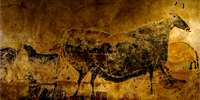 Lascaux Cave
Lascaux Cave
A rope from Lascaux Cave
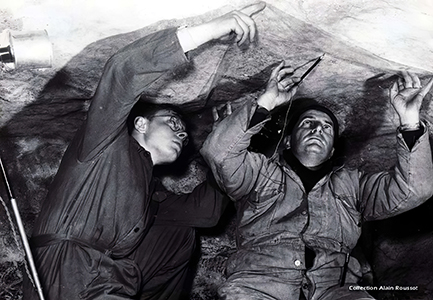
Alain Roussot and André Glory at Lascaux, 1953
l'Abbé Glory found, in 1953, the remains of a rope at Lascaux cave. He was engaged in research in the cave, and did this during the night, when there were no visitors to the cave, which had opened for tourists in 1948.
Photo: http://albuga.free.fr/fr/prehistoire/Bara-Bahau/agrandissement.html#02_P1290060.JPG
It was at the friendly insistence of l'abbé Breuil that I decided to write and to give to him this short communication for publication, in the hope that his long experience of the past would suggest to him timely comments which will fill the gaps that a more extensive study could have mitigated.
Since 1952, we have been in charge of the laborious and painful, but interesting, mission of surveying the prehistoric engravings of the Cave of Lascaux (Dordogne), under the direction of M. l'abbé Breuil, we have been the involuntary beneficiary of a a surprising discovery which is the first of its kind to be reported in a palaeolithic environment: peatified fragments of a fibre rope.
The starting point is the research we have carried out in the filling of the passage which extends along the end of the axial gallery. In fact, in order to study the engravings that we had discovered on the low ceiling, I had to clear, in order to advance there, a few metres of clay which had been deposited there to a thickness of 40 to 50 cm since the palaeolithic period.
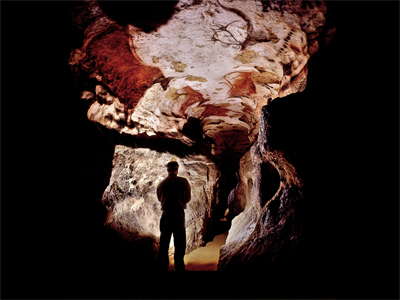
Norbert Aujoulat at the entrance to the Axial Gallery
Photo: Norbert Aujoulat
Proximal source: http://www.lascaux.culture.fr/
This filling is divided into three layers.
1. The deep layer, formed of a dark brown laminated clay, sprinkled with manganese crystals, often in contact with the host rock. This layer, which formed the first layer of the palaeolithic cave, was sterile in the places visited.
2. A layer composed of mineral and organic detritic material, 30 to 40 cm thick, having the appearance of a yellow ochre sandy-clay soil. It contains at first residues of the slow disintegration of the walls and the ceiling, constituted by Santonian and Coniacian limestone, very rich in siliceous granules and shellfish fossils, then remnants brought by man: wood charcoal often scattered in patches, pieces of peatified wood, flint cores, flakes, flint blades, fragments of black, red, pink, brown, yellow colourants; a few small bones of mole, vole, garden dormouse and reindeer, carp bones.
3. The upper layer, darker yellow in colour, 2 to 5 cm thick depending on the location, similar to silt, contained larger calcareous granules and carbonaceous particles. It was covered on the surface with a film of black dust that is also found on the engravings on the skew of the apse and which must be of aerial origin. These three layers exist throughout the cave, with variations of appearance according to the places; in the humid parts, in the bottom of the gours, ( ridges on the floor formed by calcite rich water standing for some time - Don ) the sandy-clay layer is covered by a thick deposit of carbonate of lime, or malleable calcite. They are also found in the Gallery des Felins, particularly in two places: at the foot of the panel of Felines (Cabinet des Felins) and at the foot of the panel of Horses (Cabinet des Chevaux), very close to each other.
Indeed a narrow passage, narrowing further between two rocky sections riddled with holes and bristling with sharp spikes, bordered on the ground a small strip of silt, 20 to 50 cm wide located at two of the previously named points and at a level about 120 cm below the drawings.
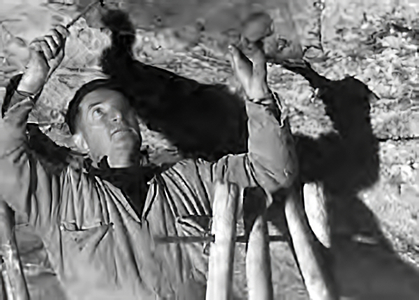
L’abbé André Glory copying drawings in la grotte de Bara Bahau.
Photo Credit: Archives A. Glory, 1955
Proximal source: http://perigord.mcweb.fr/cro-magnon-grotte-bara-bahau/
Towards two am one morning, (the recording of the engravings took place from 8 pm. to 4 am), tired of the work of copying the engravings on the ceiling of the Apse, my helpers then (in 1953), Roger Constant, Jean-Louis Pechmajou, and myself, were going to relax by looking for new drawings and exploring new galleries.
( They went to the passage of the Felines, which includes two chambers close together, the Chamber of Horses and the Chamber of Felines, passing through the Nave and the Mondmilch Gallery to get there. It is very difficult to reach because of the narrow entry, the slope of the floor, and the narrowness of the passageway - Don )
( Note that there appears to be a break in the smooth telling of the story, it becomes somewhat disjointed, and a paragraph or more seems to have been left out of the printed account, and the printer may have inadvertently transposed some paragraphs - Don )
As I had discovered new engravings of felines on the western wall that overlooked the chasm, I assumed that perhaps other graffiti had been covered by these easily relocated deposits.
The first of these pockets, 1 metre long, located in the Cabinet des Félins, contained, in layer 2, many fragments of pasty red ochre, wood peat whose shapeless pieces fell into dust, many particles of wood charcoal, two blades of black flint, and, wedged in a cleft, a proximal epiphysis of the left metacarpal of a female reindeer.
The second pocket, which was just two metres further into the Cabinet des Chevaux, 250 cm long and of medium width, had a 40 cm thick archaeological layer. It contained: a pyramidal ossicle of the right carpus of a small Reindeer, flakes of finely retouched flints, a special kind of burin little known in the West, colour palettes, colouring powders and a great abundance of charcoal and peatified wood. In the upper mass of this layer, strongly packed down by the trampling of prehistoric man, and at 5 cm from the bedrock, lay the debris of a rope about 30 cm long. Buried diagonally and oriented in the axis of the gallery towards the edge of the chasm, it could be withdrawn intact thanks to the psychological contribution of happy circumstances which deserve to be told.
I lifted the compact shell of clay that sealed this crack; the clump broke into several pieces which I took in my hands with the intention of crumbling them to check their contents. As I examined the profile of the first striated piece of thin stratified sheets, consisting of fine calcareous granules slowly fallen from the roof, I noticed a thin horizontal black thread that traversed the field from end to end.
I have always thought that palaeolithic wooden objects could have been abandoned on site by the Cromagnons and that the clay of the caves was composed of peats, aqueous silts, soils saturated with naphtha, salt, nitrate, of carbonate, of sulphate ... some of the materials best able to preserve the peat forms - provided, however, that they were almost immediately sealed.
Only the luck of undisturbed earth and examination in the laboratory would perhaps make it possible to recover it. Mechanically I struck the tip of the blade of my pocket knife into the unusual black line. According to the well-known physical observation, that a homogeneous medium splits at the place where a heterogeneous object is inserted, the small block of clay opened in two plates like the pages of a book. I saw at once the carbon print of a sort of strip with twisted lines extending along the whole length of the piece. I interpreted this as the remains of a woven braid, or something similar.
The second piece also opened in the same way, but the positive and negative traces seemed to represent a more complicated interlacing. The third packet broke along its length and was at an angle, and the fourth was not touched as a witness. The fifth showed nothing but a ribbon with no apparent structure, of blackish dust, as if crushed and spread by pressure of the feet through the thickness of the ground which had become thinner.
Intrigued by these unexpected finds, we cut the rest of the clay layer into small squares, but to our great disappointment we could not detect anything except for many smoky particles in the whole layer, probably resulting from the debris of torches or of sticks that had once served as light. I carefully put the eight pieces of clay in a hollow of the wall and returned the next day to find them and put them in an airtight aluminium box, so that they could slowly dehydrate outside and sheltered from the sun.
Seen in daylight, there was no possible doubt, the fresh impressions in relief and hollow of the first piece had the very clear characteristics of a twisted rope formed of several strands on which one could even distinguish the torsion blisters. In spite of all the precautions taken to obtain a slow desiccation, the relief figures are not as clear as in the first days, and some pieces of charcoal and clay had detached themselves from the whole.
To avoid any more regrettable damage, we had a specialist photograph the original finds, then we wet the carbonaceous imprint with plexilit ( acrylic resin ), brushing the clay with the clear varnish. Then the pieces, coated with cellophane, were put into a metal box, and placed away from the air inside a Plexiglas container lined with cotton wool.
( Dividing the Chamber of Felines in two is the deep and high 'Southern Shaft', followed by the rest of the Chamber of Felines. The remains of this Palaeolithic rope were found immediately before the Southern Shaft, the rope almost certainly being used to descend to the bottom of the shaft.
The long pole Glory found at the bottom of the shaft was used by the boys who discovered and explored Lascaux in recent times.
The remains of the rope had been covered with clay, apparently washed there, but certainly after the rope had been used and abandoned. - Don )
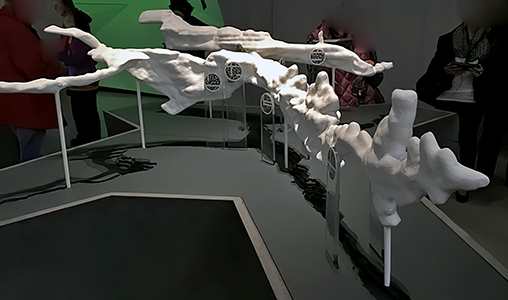
Atelier de Lascaux: a 3D digital model of the cave structure is provided, with interactive links to show which paintings are where, displayed in the recreation of Lascaux, Lascaux IV.
Photo: Veronica Simpson
Source and text: https://www.studiointernational.com/index.php/lascaux-iv-international-centre-for-cave-art-review
In the image above, the part of the model in the foreground is, in order, going backwards:
a) The end of the Chamber of Felines, with the six red dots, the head and horns of a bison, and XIII sign.
b) The Southern Shaft, a formidable obstacle, with a high vault and a low floor, dividing the Chamber of Felines into two.
c) Immediately behind the Southern Shaft is the rest of the Chamber of Felines, with the Mondmilch gallery behind that.
In the left midground can be seen the Apse and the Shaft.
Then in the right background we can see the Axial Gallery with the snake-like Terminal Passage at its end.
In the far background is the Hall of the bulls and the entrance to Lascaux - Don
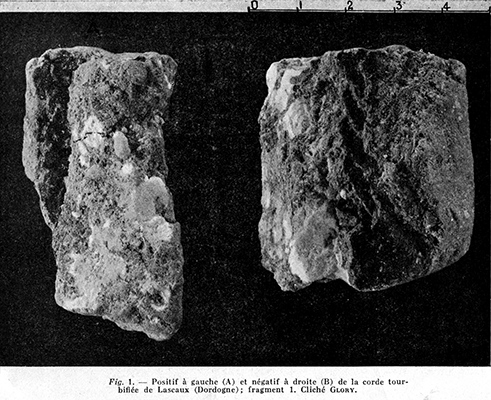
Description and interpretation of optical analysis.
Fragment No. 1. Length: 5 cm, (Fig. 1).
The positive impression plate (left on the picture) shows charcoal strands in slight relief turned to the right. With the microscope, and even with a hand lens, we perceive convex subdivisions, one of which is covered with bumps, clearly visible in the picture, at the right edge of the rope. Of ovoid shape, this small cavity presents the appearance of a micro-crater with blistered edges placed at the end of a large cavity in the cast.
Width of the impression: 6 to 8 mm.
Photo: A. Glory
Source: Glory (1959)
The negative imprint, more complete, shows a staggered group of six slanting grooves sharply imprinted in the clay. In each of them, about 1 cm long, we can distinctly see 3 or 4 cupules in a chain, produced by the pressure of the dent of the strands, which are stuck on the positive imprint. In the upper part, the slightly spaced strands indicate a part of the rope, while the inferior part, rather fuzzy, forms a small charred aggregate, apparently compartmentalised as if the strands had been disturbed and spread; also we count four well shaped and two of irregular appearance. Note also that on this negative footprint, the reverse strands are rolled to the left.
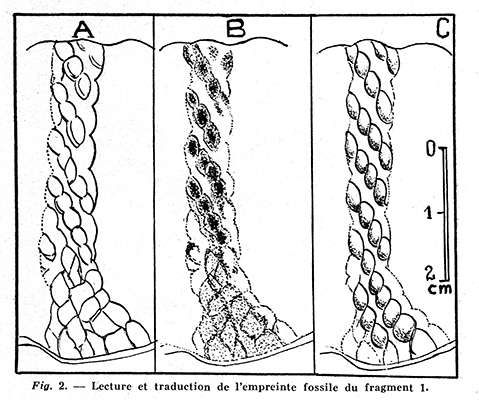
Fig. 2: Reading and interpretation of the fossil record of fragment 1.
What is the interpretation of these series of small bosses or bumps? By placing a cellophane layer on the photo and following the main contours of the charcoal traces, we obtain the drawing of the panel A, (Fig. 2). Using the original, we then add the strong shades marked by the cavity in a cast, panel B (Fig. 2). There are thus regular series of loose twists similar to those of a rope, part C. The cavities would be only a physical aspect or an alteration of the tufts due to the twisting of the strings. By reversing the layer of this drawing, it is easy to reproduce the aspect that this rope ribbed on the right could represent, taking into account that on the diagram, the volume of the tufts or bumps was exaggerated a little by design.
Drawing: A. Glory
Source: Glory (1959)
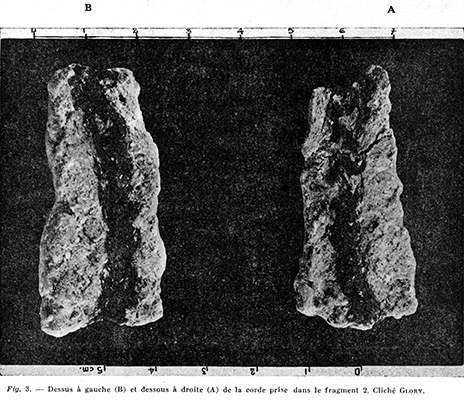
Fig. 3: Fragment 2. Length: 5 cm.
This fragment has opened in the axis of the string, so that this happy accident highlights on each panel, the winding of the fibres figured on one side on the upper face and the other on the underside of the rope. Also the relief is not much accentuated and the movement of the fibres will be reversed on the two sheets, but showing no indication of the raised bumps. Interpretation of this fragment is more challenging.
Photo: A. Glory
Source: Glory (1959)
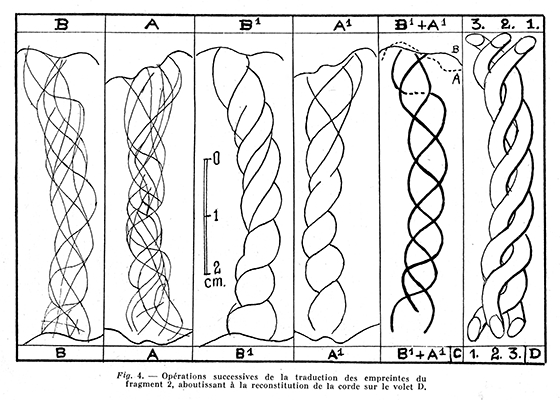
Fig. 4. - Successive operations of the interpretations of the parts of fragment 2, resulting in the reconstruction of the cord in panel D.
By drawing on each sheet, B on the left and A on the right, according to the photo and the original, the continuous lines being indicated in purposely very oblique light, it results on panel B and on panel A, a skein of lines that follow the same helical movement.
By taking only the reversed master lines, marked in dark on the photos, we get the windings B1 on the left panel and A1 on the right panel. By superimposing the two layers so that A1 is turned upside down on B1, we see in transparency the helical movement of all the strands (panel C). We then notice that in the last panel (D) the rope was composed of three regularly spiralled strands.
These are manifested on the two imprints by a twisted tow of coarse fibres where we see some carbonaceous scales, a fringing on the sides of twin scallops that represent the outer contours of twists or coils deformed by compression of the clay or by a poor manufacturing method.
Width of the impressions: 5 to 7 mm.
Drawing: A. Glory
Source: Glory (1959)
Fragment # 3. Length: 7 cm.
The third sample, which had been broken at an angle in the fresh state, was worked in the dry state. Desiccation had made it very hard. With a thin metal point, I scraped the clay until meeting a carbonised print.
Then, with fine forceps, I removed the body of the rope, which was thus detached from small cylindrical granules and thin scales which were placed in a tube for micro-analysis. The indented clay impression representing the outer shape of the cord which had retained its volume could be moulded by Dr. Hodel and his assistant, thanks to the plastic Imprex, the name of a recent powder used in dental prosthesis.
The concave enveloping sheath is in the form of a more or less cylindrical groove with a diameter of about 6 to 8 mm. It is streaked with helical spiral grooves, especially visible in the upper part of the original (Fig. 5), reproducing the reliefs of the strands, whose number of coils is 13 in 7 cm, which does not correspond with that of the first fragment, which had six windings on the first two fragments, which gives an average of 3 coils or windings for 2 cm.
The plaster relief moulding obtained by M. Hodel, from the lmprex cast, highlights certain details of structure: slightly raised egg shaped ovals cross the strands; they correspond to the small cupules so visible on the first negative fragment. In the lower part, in very low relief, there is a bundle of some parallel and circumferential fibres (Fig. 5).
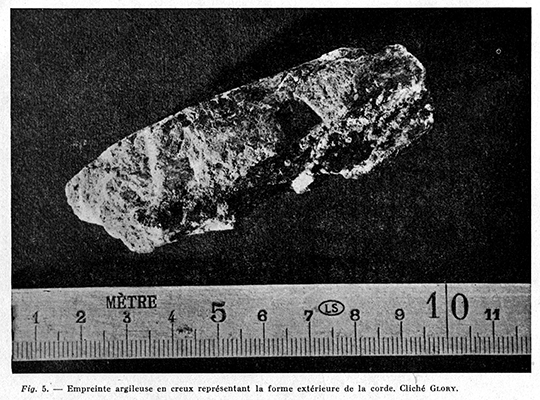
Fig 5: Impression in clay showing the outer shape of the rope.
Fragment No. 4. Length: 4.5 cm.
To preserve an intact witness, this fragment, of which we can see in section a thin black line, was not opened up.
Fragment No. 5. Length: 5 cm.
The piece containing the rope, which carried layers from the old ground was able to be opened without difficulty since the block of clay crumbled easily.
The fibres, probably crushed, present no more than a dusty trace widened to 12 mm, without visible structure. In short, in this analysis, it is a piece of rope about 30 cm long, 7 to 8 mm wide, shaped with three strands twisted to the right. With a thickness of about 3 mm, the twine of the strands is roughly twisted not with crushed or combed fibres, but with woody filaments that seem to have kept some roughness. The twisting gives three coils on a length of 2 cm, on average.
Photo: A. Glory
Source: Glory (1959)
These data allow us to reconstitute the look of this rope, with all the caveats that always attend this difficult work (Fig. 6).
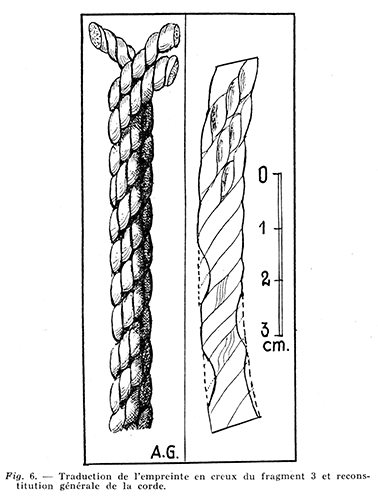
Fig. 6: Drawing of the imprint of fragment 3 and general reconstruction of the rope.
Are these filaments cellulosic fibres like those of flax, lignified fibres like jute and straw, or cortical strips of young stems like tapa?
Optical observations tend to favour lignified fibre strands, but bundles of young bark do not seem to be thus excluded; they must have undergone a simple retting preparation, namely rorage (exposure of the stems to the air or to Dew) or retting in still water. Can chemical analysis give more precision?
Drawing: A. Glory
Source: Glory (1959)
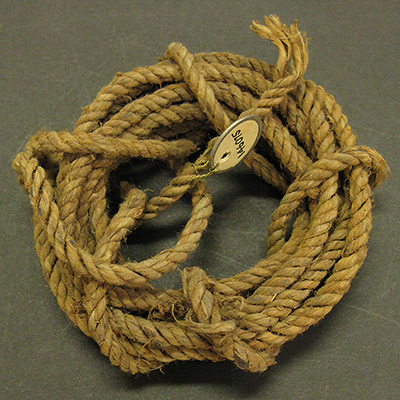
This is an example of what the Lascaux rope may have looked like. The yarn (of bast, vegetable fibre) was S twisted in the first place, then plied with three of these in the Z orientation. Yarns are plied in the opposite direction to the one in which they were spun.
Photo: From the collections of the Yale Peabody Museum of Natural History, https://collections.peabody.yale.edu/search/Record/YPM-ANT-146075
Catalog: Three-ply cord, of baliti bast. Length 8'7''. Hanunoo, Mindoro, Philippines, Malaysia.
Catalog Number: YPM ANT 146075
Department: Anthropology
Summary Data: Three-ply cord, of baliti bast. Length 8'7". Hanunoo, Mindoro, Philippines, Malaysia.
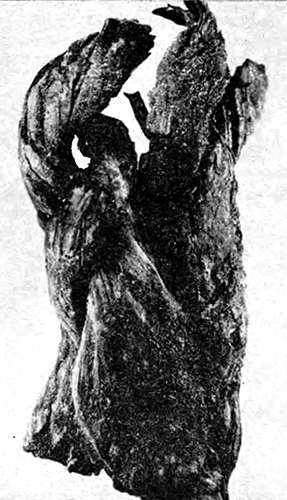
Fig. 7: Piece of birch bark rope from the iron age La Tène culture.
Provenance: Nacqueville-le-Bas (Manche).
Original kindly made available by the Curators of the Museum of Cherbourg, MM. Herpin and Bogard.
Photo: A. Glory
Source: Glory (1959)
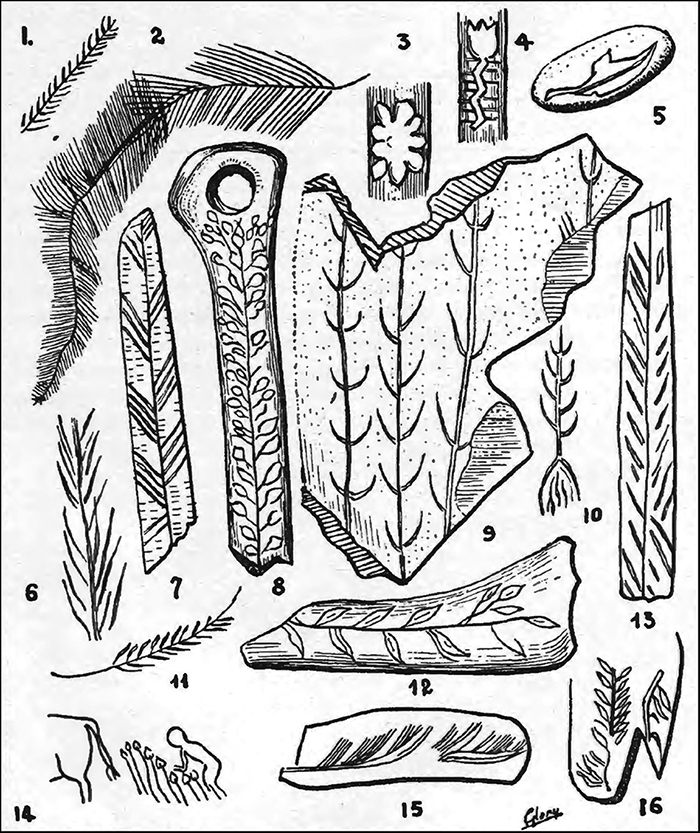
Fig. 8.
( these drawings are included by Glory to convey the importance of vegetable products in the life of Palaeolithic humans - Don )
1 Teyjat (Dordogne), after Rev. Mensuelle, 1908.
2 Grotte de Lascaux (Dordogne), Glory.
3 La Madeleine (Dordogne), after Breuil and Saint Périer.
4 Laugerie Basse (Dordogne), after Breuil, Cartailhac.
5 Grotte de Gourdan (Haute Garonne), after Piette.
6 Grotte d'Isturitz (Basses Pyrénées), after Passemard.
7 Laugerie Basse (Dordogne), after Breuil, Cartailhac.
8 Station de Veyrier (Haute-Savoie), Musée de Genève.
9 Grotte de Gourdan (Haute Garonne), after Piette.
10 Grotte du Mas d'Azil (Ariège), after Piette.
11 Grotte d'Isturitz (Basses Pyrénées), after Passemard.
12 Grotte du Trilobite (Yonne), after Parat.
13 Laugerie Basse (Dordogne), after Breuil, Cartailhac.
14 Grotte du Mas d'Azil (Ariège), after Piette.
15 Grotte du Mas d'Azil (Ariège), after Piette.
16 Grotte des Espélugues (Hautes Pyrénées), after Piette.
Charente (Teyjat), and Yonne (Trilobite), see Fig. 8, betray, in Homo sapiens, interested concerns about the value of the plant biosphere, whose uses can be assumed from these discoveries.
Source: Glory (1959)
Authenticity and Chemical analysis
1. The place, date and circumstances of the discovery were briefly recorded in a report dated 25th September, 1953, the signatures of which were signed by the Mayor of Montignac (Dordogne).
2. A survey of farmers living on the Hill of Lascaux, MM. Baudry, Beauvais, Latoour, Parvau, Requier, pointed out that sixty years ago, so around 1890, the dome of the hill where the cave is situated was covered with vines; nothing remarkable had been noticed. As a result of the Phylloxera depredations, the vines were torn out and replaced by a Scotch Pine plantation. The roots of these trees disrupting the subsoil probably initiated a collapse zone at the intersection of two natural fractures where the entrance is now located.
We remember seeing the 'hole' already before the Great War 1914. What is certain is that no one had gone down before the young Ravidat on September 12, 1940, and to enter it, the teenager had to force his entry by clearing earth and rock, and pushing hard with shoulders and elbows.
3. Since this discovery, the Galerie des Félins has been little used and has not been equipped for routine visits. The discoverers had thrown into the chasm, to get down, a long pole that I found mouldy on the surface, but not at all in a state of peatification ( the process of partial decomposition of plant material in a swampy, waterlogged environments - Don ). The soil covering the rope buried in the upper part of the archaeological layer was composed of layered deposits of carbonate and clay, very horizontal.
As we observed in 1953, at the Cave of Reignac near the Moustier (Dordogne), following a change in atmospheric conditions, the soil was covered with a carpet of limestone dust fallen from the ceiling. These successive deposits at Lascaux are not indicative of a reworked terrain and recent formation.
4. In our opinion this rope oriented in the axis of the gallery, one end of which was close to a kind of natural gutter which extended into the abyss, seems to have formerly served for the prehistoric artists to descend the 6 metre high cliff.
We searched the bottom which was composed of 3 layers; from top to bottom, we found:
a) A first layer of very wet plastic hydrocalcite, a kind of mondmilch, 10 to 15 cm thick. ( Mondmilch, or moonmilk, is a white, creamy substance found inside limestone caves. It is a precipitate from limestone comprising aggregates of fine crystals of varying composition usually made of carbonates such as calcite, aragonite, hydromagnesite, and/or monohydrocalcite - Don ).
b) A pavement of natural flat stones placed next to each other, of Palaeolithic period.
c) A deep layer of pasty hydrocalcite, mixed with abundant carbonaceous particles and red ochre; just beneath the pavement lay, in line with the Bison engraving located 6 metres higher, a blade of flint, with the edges finely blunted by abrasive retouching.
5. Does the transformation of an organic matter into peat, humified, or carbonified derivatives indicate a very long elapsed time? Can chemical analysis give an answer? The chemical composition of lignified cells is still poorly understood. The lignin could be separated from the cellulose. These two elements break down over time, under the action of bacteria and natural corrosive agents in mineral debris (Carbon Dioxide, water, and ammonia) and in humic substances that were formerly called dopplerite. ( Dopplerite is a naturally occurring organic substance found in amorphous, elastic or jelly-like masses, of brownish-black color, in peat beds in Austria and in Switzerland. It is tasteless, insoluble in alcohol and ether, and is described by James Dwight as an acid substance, or mixture of different acids, related to humic acid. It may be the same as Gyttja. - Don )
This body, of the appearance of asphalt, which dissolves in alkaline solutions, increases in proportion with the time. This is the substance by which tertiary lignites contain half or even more of their weight.
Then, in an inverse process, the humic substances are broken down over millions of years, so that almost no traces are found in anthracite. The recent research of D. Waksman (Nobel Prize, 1952) on streptomicin, of which he is the discoverer, led him to investigate this question without solving it. According to this researcher, cellulose, a condensation product of glucose, disappears over time. Lignin is transformed into a dark brownish dark substance (dopplerite) which contains the following 3 groups of compounds: humins, fulvic acids and humic acids. Despite numerous laboratory analyses, their chemical formula is not yet known, but they are distinguished by their chemical properties. Humic acids in larger quantities, resist longer degradation and would be a complex of proteins and lignins more or less oxidised.
Mr. Koby rightly points out that animal substances, such as those of the cave bear, are also transformed into humic bodies. But their blackish deposits will be scharizerite, which is distinguished from dopplerite by a higher nitrogen content, usually above 10%. ( Scharizerite was originally described from the Drachenhöhle, Mixnitz, Frohnleiten, Styria, Austria, and may have been a residue of the bodies of the cave bears whose skeletons were found there in profusion - Don ) One could thus by analysis discern the two origins. In the present state of science, it seems to be admitted that plants and animals leave in the caverns humic residues in the form of blackish and burnt deposits, and that, according to the age of the archaeological layers, these deposits are ancient but the magnitude of the time factor in relation to the nature and quantity of the various transformed humic substances is unknown. These general questions seemed useful to me here, because they will help to appreciate the result of the chemical analysis made by the Institute of Botany of the Faculty of Sciences of Strasbourg.
I warmly thank Professor Lemée and his Assistant Mr. Paul Lossaint for giving us the following note:
Laboratory of Phytosociology and Pedology
Strasbourg, 2nd July, 1954.
The fossil cord specimen given to us by Father Glory was submitted to the chemical and optical analysis.
1. The treatment of the sample with 5% sodium hydroxide shows that a large part is soluble in this solvent and reprecipitable in part with hydrochloric acid. This demonstrates the presence of humic acids. In addition to this essential product, there are fulvic acids which remain soluble in a medium of hydrochloric acid. The rope in question, therefore, is not charred, but humified. This humification almost completely destroyed the plant cells and gave rise to an amorphous black-brown substance with the appearance and characteristics of peat. The lignin and cellulose that constituted these vegetable remains underwent transformations. They no longer give the characteristic reactions with phloroglucin and with zinc chloroiodide.
2. Examination of the sample with a magnifying glass makes it possible to clearly distinguish a fibrous structure. Freezing microtome sections of 10 μ did not detect well-defined cells; it is therefore impossible to determine the origin and nature of the plant used for making the rope.
Paul Lossaint, Att. of Researches C.N.R. S.
3. The microscopic observation by simple shredding in water, likewise shows fragments of fibres, but no sclerous or cork cells, which does not allow us to assign to it with some certainty a cortical origin. The presence of many spores of fungi shows that they are the authors of humification. The humic state of the sample seems to show its age.
G. Lemée, University of Strasbourg.
Anxious to detect possible fraud, in 1953 we asked Professor Pivetau to put us in touch with a specialist in plant biology working in the Sorbonne laboratories. Mr. Louis Grambast, after a binocular microscope examination of a sample of this rope, told us: 'The peat-like aggregate is composed of carbonaceous pieces that show up as flakes with an appearance of ligneous structure whose non-dissociated fibrous elements have remained grouped in a plane. One has the impression of a bark ribbon whose twists have been flattened by the pressure.
In summary, laboratory research that could be done despite the state of advanced fossilisation of this rope shows that it was a vegetable matter with lignin fibres, not necessarily of cortical origin, a rather pronounced peatification making it no longer possible to distinguish the shape of the fibrous cells that would have then made it possible to determine the nature of the plant used.
The state of carbonification is a favourable indicator in favour of its great age. The grouping of the fibres, remaining associated with each other on the same plane, would make one think of the use of herbaceous textile stems and even perhaps of strips of young bark with cells not yet impregnated with suberin (cork) as that of the phellodermic zones.
( The phelloderm is the layer of tissue, often very thin, produced on the inside of the cork cambium in woody plants. It forms a secondary cortex - Don ).
Unfortunately, the magnitude of the degradation time of sclerotic cells is not known.
The role of cords in the economic life of Homo sapiens.
Predisposition of the climate and iconography
Pollen analysis has made it possible to reconstruct, at least in outline, the vegetal landscapes of Quaternary soils. Despite the reluctance of a particular director of the Institute, the palynologists have been able to observe that pollens have been preserved in the palaeolithic deposits, even the ancient layers, but that the silhouette of their grains had been deformed by the humic acids, which requires special work to identify them. According to Professor Lemée's (1952) pollen maps, it seems that during the Würmian period, Périgord was at the limit of the steppes-tundras and the subarctic forest area of large birch, pine and of willows, and thus without thermophilic species.
According to the work of M. Bouchud (1952) on the small group of fauna of deposits at Lachaud near Terrasson and Castanet near Sergeac, under the influence of a warming of the temperature, the region of Montignac had again improved its forest-park site from Aurignacian II period to the Magdalenian II by an upsurge of woods, scrub and swamps. It is in this flora of shrubs and herbaceous plants that prehistoric peoples could choose their fibrous raw material from broom, birch, willow, nettle, and others.
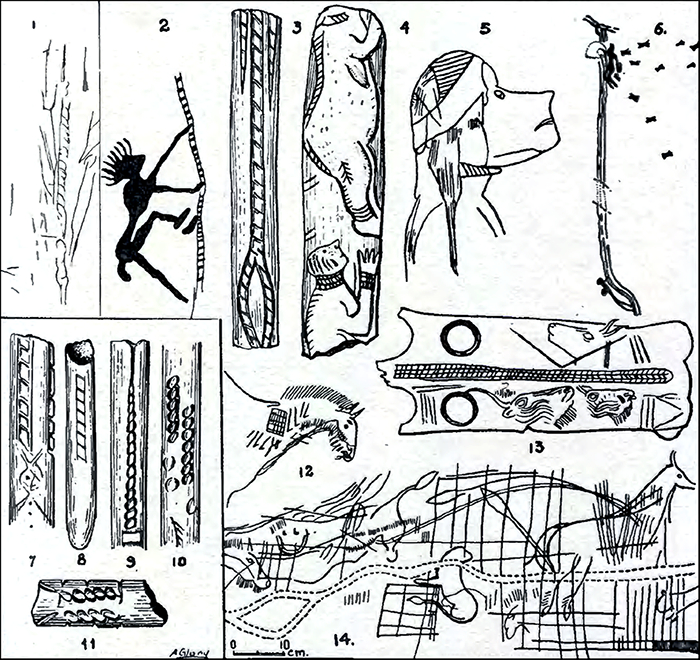
Fig. 10.
( these drawings are included by Glory to demonstrate the use of cordage symbols in the art of the Upper Palaeolithic - Don )
1 Station du Bonhomme (Dordogne), after Sauter.
2 Abri Rémigia (Castellon, Spain) , after Obermaier.
3 Bruniquel, (Tarn-et-Garonne), after Breuil and Saint Périer.
4 Grotte d'Isturitz (Basses Pyrénées), after Saint Périer.
5 Grotte de la Marche (Vienne), after Lwoff.
6 Abri de la Arana (Bicorp, Spain), after H. Pachéco.
7 La Madeleine (Dordogne), after Capitan and Peyrony.
8 Pech de la Boissière (Dordogne), after Peyrony.
9 La Madeleine (Dordogne), after Capitan and Peyrony.
10 Laugerie-Basse, (Dordogne), after Breuil.
11 Grotte des Espélugues (Hautes-Pyrénées), after Piette.
12 Grotte de Lascaux (Dordogne), drawing by Glory.
13 La Madeleine (Dordogne), after Capitan and Peyrony.
14 Grotte de Lascaux (Dordogne), drawing by Glory.
Source: Glory (1959)
Thus we are not surprised to find engravings of twisted links on a Reindeer wooden baguette fragment from the Cave of the Espelugues (Hautes Pyrénées), from the Madeleine (Dordogne), and on another half-round baton from Laugerie-Basse (Dordogne), with helicoidal spirals, though made well after two unsuccessful attempts (Fig. 10). Many engravings also present oblique striated ribbons (La Madeleine, Pech de la Boissiere (Dordogne), Bruniquel (Tarn-et-Gronne) (Fig. 10), but could they also be more schematic representations of ropes?
Testimonials of bone and lithic materials
The existence of cords and ropes, which is not invalidated by the rigour of the climate, nor by the absence of representations, seems to even be attested much previously by the traces of wear left on some palaeolithic objects in bone and stone.
References
- Breuil H., 1959: Découverte par M. l'abbé Glory de débris de corde paléolithique à la grotte de Lascaux (Dordogne), Comptes rendus des séances de l'Académie des Inscriptions et Belles-Lettres, 99ᵉ année, N. 2, 1955. p. 194; doi : https://doi.org/10.3406/crai.1955.10431 https://www.persee.fr/doc/crai_0065-0536_1955_num_99_2_10431
- Glory A., 1959: Débris de corde paléolithique à la grotte de Lascaux (Dordogne), Mémoires de la Société Préhistorique Française 5, p 135-169.